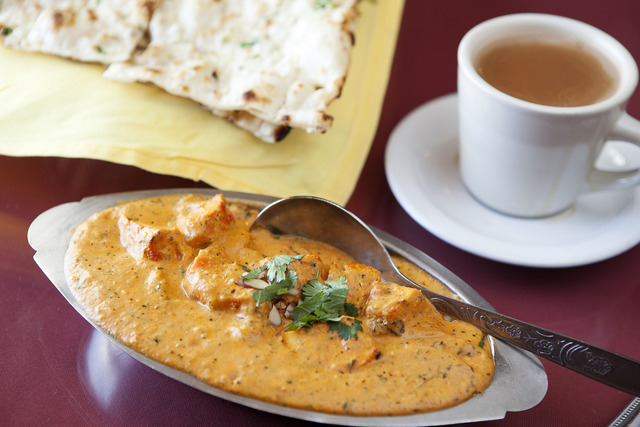Like its namesake, Taj Mahal Cuisine of India is housed in a large structure. The south entrance, extended by a snazzy canopy, juts into the Smith’s parking lot on Carlisle and Constitution, but regulars don’t use this entrance, as it entails a long walk, down some stairs, past an empty banquet hall and up more steps to where the action is. Parking beneath the iconic pink and purple neon sign, in the thin parking strip between the Taj and Carlisle, allows access to a door that opens directly into the main dining room.The 18-year-old business bustles with a smooth efficiency I recognize from Indian restaurants in India. The servers play team defense, as electric Hindupop softly pulses, and the kitchen quietly bustles behind the cash register. The hostess is sweet and calm, with a mischievous glint in her eyes. She will help you order if you’re in over your head. All of the cooks, she told me, are from Punjab, a region in the mountainous north of the country, along India’s border with Pakistan. The cuisine, she told me, is a Punjabi take on north Indian classics.One of the best is ghost saagwala—succulent pieces of lamb simmered in a spinach sauce. In the old country it’s more often made with mutton, but here the tender, cradle-robbed chunks of lamb are hardly an unwelcome substitute. The strong flavor of sheep is a good balance against the harmonious blizzard of spices found in nearly every dish at Taj Mahal, and all of the lamb dishes we tried were exquisite, including the blazingly spicy (as warned of in the menu) ghost mirch masala—lamb with potatoes and red chile—and the spectacular Gobi ghost, in which soft lamb chunks luxuriate in a rich, thick, cauliflower-based curry.Cauliflower, like spinach, is a cold weather crop that grows well in the Himalayan foothills or in North India, and both spinach and cauliflower sauces appear elsewhere on the menu. Don’t pass them over, including the perennial vegetarian favorite saag paneer, in which homemade cheese is bathed in spinach sauce, or the murg gobiwala, chicken in a tangy cauliflower sauce with tomato and curry, a bright, succulent dish that was my favorite entry in the lunch buffet.Like the menu, the buffet is rich with vegetarian options—a good thing as the vegetarian dishes of India are on another level. India is a country where we could eat happily without meat, and because so many Indians feel the same way, it’s common in India for restaurants to display the status of their food with the terms “veg” and “non-veg” in plain view from outside. “Non-veg,” it must be noted, is not to be confused with vegan, as the food contains dairy products galore. The Navrattan korma is about as decadent as you can get—a buttery, creamy curry sauce in which mushrooms and peas float with sauce-drenched eggplant, potatoes, raisins and crunchy nuts. The channa pindiw, in which chick peas are cooked with tomatoes in an inscrutably complex array of spices, is good, too. Most of these dishes contain a lot of yogurt, cheese and butter.These crèmes are hardly limited to the vegetarian options. One of the restaurant’s signature sauces, makhani, is Punjabi for “in butter,” and includes not just butter, but yogurt and cream. In the chicken (murg tikka) makhani, chunks of tandoori chicken are simmered in a spicy tomato butter sauce. We ordered a plate of tandoori shrimp with makhani sauce on the side, for shrimp dipping pleasure, and that worked out very well. Lamb and beef makhani are available as well, although I don’t know anyone who orders beef at an Indian restaurant.That orange-hued makhani sauce also bathes a ball of chickpea flour in one of the many courses—I counted six—in the vegetarian thali meal, served in the traditional style via a series of metal bowls on a tray. The meal includes a hearty potato and pea samosa, a whole wheat naan bread and dessert—I chose the pudding-like mango custard. The chai tea is abrasively spiced and unsweetened, which sets it apart from the wannabe stuff. Every time I finished my glass, it was refilled, as was the case with the iced chai. Alas, the same could not be said for the Casa Rondeña table red wine on the wine list. You have to pay for those refills, but they’re well worth it. Taj Mahal makes an intriguingly tangy mango lassi as well.Another refreshing dish that I made a mental note of and filed away for summer is the refreshing kachumber salad. Large chunks of crispy, juicy cucumber and tomato tossed with bell pepper slices in a tangy, tamarind citrus red chile dressing with the usual myriad earthy spices. It’s a completely unexpected and graceful combination that I will be returning for when the temperature rises.But winter is the season of comforting, insulating fat like butter, cream, yogurt and melted spiced animal parts. If that sounds good to you, this Punjabi kitchen will probably keep you very happy.
Taj Mahal Cuisine of India
1430 Carlisle NE
tajmahalcuisineofindia.com255-1994
Hours: 11am to 2:30pm and 5pm to 9:30pm Sunday through Thursday11am to 2:30pm and 5pm-10pm Friday and SaturdayVegetarian Options: Yes, but vegans won’t have much luck.Décor: Well-worn but still classy.The Weekly Alibi recommends Ghost saagwala (lamb in spinach sauce), Murg tikki makhani (tandoori chicken in tomato butter curry), Kachumber salad, Mixed veggie thali (a vegetarian multi-dish meal).











